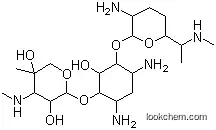10.1080/00021369.1982.10865090
The research investigates the biotransformation of sisomicin and verdamicin by Micromonospora sagamiensis. The study found that the resting cells of a 2-deoxystreptamine idiotrophic mutant of M. sagamiensis could transform sisomicin into gentamicin CIa and sagamicin, while verdamicin was transformed into gentamicin C2a, C2, and then CI. The biotransformation products were isolated using ion exchange and carbon column chromatographic procedures and identified through various analytical techniques. The study also compared the biotransformation capabilities of other Micromonospora species, such as M. zionensis and M. inyoensis, and found that they lacked the (4',5')-reduction activity present in M. sagamiensis. Instead, M. zionensis transformed sisomicin into antibiotic G-52 and verdamicin into a new antibiotic, VF3-1, which was suggested to be 6'-N-methylverdamicin based on chromatographic and mass spectrum data. The findings provide insights into the biosynthetic pathways of these antibiotics and their potential for further development.
10.3390/antibiotics8040212
The research focused on synthesizing berberine derivatives to inhibit MexXY-dependent aminoglycoside resistance in Pseudomonas aeruginosa. The study synthesized 11 berberine derivatives and tested their inhibitory activities against MexXY in both MexXY-positive and MexXY-negative P. aeruginosa strains. The most potent derivative, 13-(2-methylbenzyl) berberine (13-o-MBB), was found to reduce the minimum inhibitory concentrations (MICs) of various aminoglycosides significantly in a multidrug-resistant P. aeruginosa strain. Experiments involved assessing MICs, determining fractional inhibitory concentration (FIC) indices to evaluate synergistic effects, and conducting time-kill assays to measure bactericidal activity. The analyses included NMR and mass spectrometry for compound characterization and CLSI standards for categorizing antibiotic susceptibility. The study concluded that 13-o-MBB is a more potent inhibitor of MexXY-dependent aminoglycoside resistance than berberine, offering a promising approach to overcoming antibiotic resistance in P. aeruginosa.



